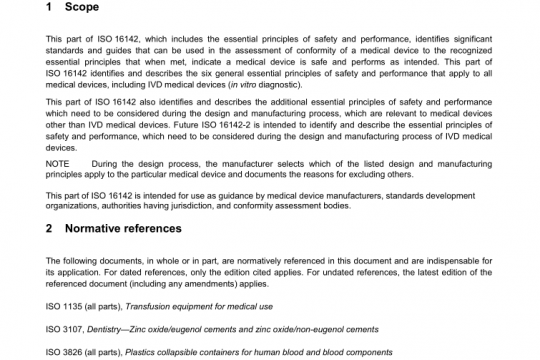AAMI EC12 pdf free download
AAMI EC12 pdf free download.Disposable ECG electrodes.
2 Normative references The following standards contain provisions that, through reference in this text, constitute provisions of this standard. At the time of publication, the editions indicated were valid. All standards are subject to revision, and parties to agreements based on this standard are encouraged to investigate the possibility of applying the most recent editions of the standards indicated below. The Association for the Advancement of Medical Instrumentation maintains a register of currently valid AAMI/American National Standards. ASSOCIATION FOR THE ADVANCEMENT OF MEDICAL INSTRUMENTATION. Cardiac monitors, heart rate meters, and alarms. ANSI/AAMI EC1 3:1 992. Arlington (Vir.): AAMI, 1 992. American National Standard. ASSOCIATION FOR THE ADVANCEMENT OF MEDICAL INSTRUMENTATION. ECG cables and leadwires. ANSI/AAMI EC53:1 995. Arlington (Vir.): AAMI, 1 995. American National Standard. ASSOCIATION FOR THE ADVANCEMENT OF MEDICAL INSTRUMENTATION. Biological evaluation of medical devices—Part 1: Evaluation and testing. ANSI/AAMI/ISO 1 0993–1 :1 997. Arlington (Vir.): AAMI, 1 997. American National Standard. ASSOCIATION FOR THE ADVANCEMENT OF MEDICAL INSTRUMENTATION. Medical devices—Symbols to be used with medical device labels, labeling, and information to be supplied. AAMI/ISO TIR1 5223:1 999. Arlington (Vir.): AAMI, 1 999. AAMI/ISO Technical Information Report.
3 Definitions and abbreviations For the purposes of this AAMI standard, the following definitions and abbreviations apply. 3.1 DC offset voltage: The voltage across a gel-to-gel electrode pair due to the difference in their electrode half- cell potentials. 3.2 disposable: Designed for single patient use. 3.3 ECG: Electrocardiograph; electrocardiography. 3.4 electrode system: A device composed of a sensing element and an electrolyte provided with the sensing element by the manufacturer or specified by the manufacturer. NOTE—That is, the sensing element may be pregelled or be a conductive semisolid (see 3.9), or it may require application of an electrolyte by the end user according to manufacturer’s instructions (non-pregelled). 3.5 impedance: A combined measure of the opposition to current through the electrode interface (resistance) and of the ability to store charge at the interface (capacitive reactance), in response to a sinusoidal current.
3.6 nonpolarizing electrode: An electrode that will not form a DC offset voltage when subjected to a DC current at a level normally encountered in clinical use. 3.7 offset instability: The rate of change in DC offset voltage over a period of time due to variations in the half- cell potential of the electrode. 3.8 pouch: The smallest package, for a specific model, that still provides protection for the electrode from environmental conditions. 3.9 pregelled electrode: An electrode in which the manufacturer has placed the electrolyte in contact with the sensing element. 3.10 simulated defibrillation recovery: A test that will evaluate the ability of the electrode to allow the ECG trace to return after defibrillation.4 Requirements 4.1 Labeling requirements In addition to the requirements of applicable federal regulations, the labeling for disposable ECG electrodes shall comply with the provisions of this section. The labeling accompanying the device shall include, as a minimum, the following information: a) a statement indicating the date beyond which conformance of the device with the requirements of this standard cannot be assured (for example, “use before ________”) and the lot number, or a statement indicating the date of manufacture, shelf life, and lot number; b) appropriate precautions and warnings, including limits of duration of electrode application and an indication of the useful out-of-pouch shelf life of the product; if the electrode should be used immediately upon opening the pouch, then an appropriate caution shall be indicated; c) appropriate instructions for use, including procedures for skin preparation, and for electrode preparation if the electrode is not pregelled (for example, gel type and gel amount); d) instructions concerning storage requirements, if applicable.AAMI EC12 pdf download.
Other IEC Standards
-

ANSI AAMI ISO 16142-1 pdf free download – non-IVD medical devices and guidance on the selection of standards
AAMI standards list DOWNLOAD -

ANSI AAMI ISO 16142-2 pdf free download – General essential principles and additional specifc essential principles
AAMI standards list DOWNLOAD


